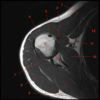Shoulder/ Arm Flashcards
Anatomic Location of Brachial Plexus
Trunks: Above clavicle. Ontop of anterior scalene, lateral to interscalene space.
Divisions: Posterior to clavicle
Cords: Oriented in relation to axiallary a. (med, lat, post). Posterior to pec minor.
Boundaries of the Axilla
- Posterior: subscapularis & teres major
- Anterior: pec major & minor, subclavius & clavipec fascia
- Medial: upper seratius anterior.
- Inferior: 4th rib
Draw the Brachial Plexus
Branches:
- Dorsal Scapular- Rhomboids, levator scapulae
- N. to Subclavisu - Subclavius
- Long Thoracic- Serratus Ant.
- Suprascapular N. - Supra & Infra
- Upper Subscapular N. - Subscapularis & Teres Major
- Lower Subscapular N. - Subscapularis & Teres Major
- Thoracodorsal - Latissiumus Dorsi
- Medial Pectoral N. Pec Minor, Pec Major
- Lateral Pectoral N. Pec Major
- Med Antebrachial Cutaneous N of Arm - medial sensory to arm
- Med Antebrachial Cutaneous N. of Forearm - medial sensory to forearm
- Musculocutaneous
- Median
- Ulnar
- Radial
- Axillary

Describe the Orientation of the Glenoid & Scapula
Glenoid:
- 7 degrees retroverted, to 10 degrees anteverted
- 5 degrees superior angulation
- Reletive to long axis of the scapula (on a sagittal cut, a line bisecting the glenoid through the apex of the scapula)
Scapula:
- 3 degrees superior tilt
- Lays 30 degrees anteverted relative to chest wall (hugs the chest wall as it curves around your flank)

Neck Shaft Angle of Humerus
130 Degrees compared to transepicondylar axis of humerus
Parsonage Turner Syndrome
Neuritis of the brachial plexus
- Sudden onset pain and paresthesias down the arm
Commonly affects C5, C6, suprascapular n., long throacic n., axillary n.
Self-limiting with prolonged recovery (1-2) years
Scapular Winging (Definitition, Affected Muscles & Associated N.)
Def’n: Deviation of the apex of the scapula reletive to its normal orientation
- Medial: Serratus Ant (Long Thoracic N.)
- Lateral:
- Rhomboids (Dorsal Scapular N.)
- Trapezius (Accessory N. [CNXI])
Preclavicular Branches of Brachial Plexus
- Dorsal Scapular N.
- Long Throacic N.
- N. to Subclavius
- Suprascapular N.
Coracohumeral Ligament (Attachements? Function?)
Attachements: Base of coracoid to superior aspect of anatomic neck of humerus
Function: Resists superior translation and ER (similar to SGHL)
Attachements to the Coracoid (Ligaments & Tendons)
Ligaments:
- Coracoclavicular Ligaments
- Trapezoid (lateral)
- Conoid (medial)
- Coracohumeral Ligament
- Coracoacromial Ligmaent
Tendons:
- Coracobrachialis
- Pec Minor
- Short Head of Biceps
Grading of AC Joint Injuries
- No displacement: AC and CC ligaments intact. Sprain.
- Disruption of AC ligaments, <50% displacement. CC ligaments intact
- 50-100% displacement. AC and CC ligaments disrupted.
- Posterior dislocation of the clavicle into trapezius fascia
- 100-300% displacement of clavicle. AC, CC disrupted. Deltoid and trapezial fascia disrupted.
- Clavicle displaced inferior to coracoid
Muscles Connecting the Upper Limb to the Thoracic Wall
- Serratus Anterior
- Pec Major
- Pec Minor
- Subclavius
Muscles Connecting the Upper Limb to the Vertebral Column
- Trapezius
- Latissimus
- Rhomboid Major & Minor
- Levator Scapulae
- Sternocleidomastoid*
Variations in the Capsolabral Complex
- Sublabral Foramen: detatchment of the anteriosuperior labrum. Does not extend past 3’o’clock
- Sublabral Recess: detatchment of the superior labrum often mistaken for SLAP tear
- Buford Complex: Congenital abscence of anterosuperior labrum with cord-like MGHL. Present in approx 2% of population.
Inferior Glenohumeral Ligament (IGHL)
- Anterior IGHL:
- Resist inferior translation
- Effective in 90 degrees abduction
- Posterior IGHL
- Resists posterioinferior translation
- Effective in IR and Adduction with shoulder flexed
Middle Glenohumeral Ligment (MGHL)
- Resists inferior translation and ER
- Effective in 45 degrees abduction
Superior Glenohumeral Ligament (SGHL)
- Resists Inferior translation and ER to a lesser extent
- Effective in Adduction with no shoulder flexion
Capsualar Ligaments of the Shoulder
- SGHL
- MGHL
- IGHL (anterior and posterior)
Types of Sternoclavicular Joint Dislocations
Type A: Posterior Dislocation (requires surgical reduction with thoracics incase of pleural damage)
Type B: Anterior Dislocation
Ligaments Attached to the Scapula (Extrinsic & Intrinsic)
- Extrinsic:
- Acromioclavicular
- Coracohumeral
- Coracoclavicular (conoid & trapezoid)
- Intrinsic
- Superior Transverse Scapular Ligament (runs over suprascapular notch)
- Inferior Transferse Scapular Ligament (glenoid rim to base of acromion
- Coracoacromioligament
Ligaments of the Sternoclavicular Joint
- Anterior sternoclavicular ligament
- Posterior sternoclavicular ligament
- Intraclavicular ligament
- Costoclavicular ligaments
Subscapularis Management
- Subscap Peel
- Subscap Tenotomy
- Subscap Split
- Osteotomy
Superior Shoulder Suspensory Complex (SSSC)
- Glenoid
- Acromion
- Coracoid
- AC Joint
- CC Ligaments
- Distal Clavicle
Disruption of 2 of the above makes an unstable ring and can be a *soft* indication for surgical fixation.
Glenohumeral Joint Stabilizers (Static & Dynamic)
Static:
- Bony Articulation
- Labrum
- Capsulular Ligaments
- Negative Pressure
Dynamic:
- Long head biceps
- Rotator Cuff x4
- Scapulothoracic motion





